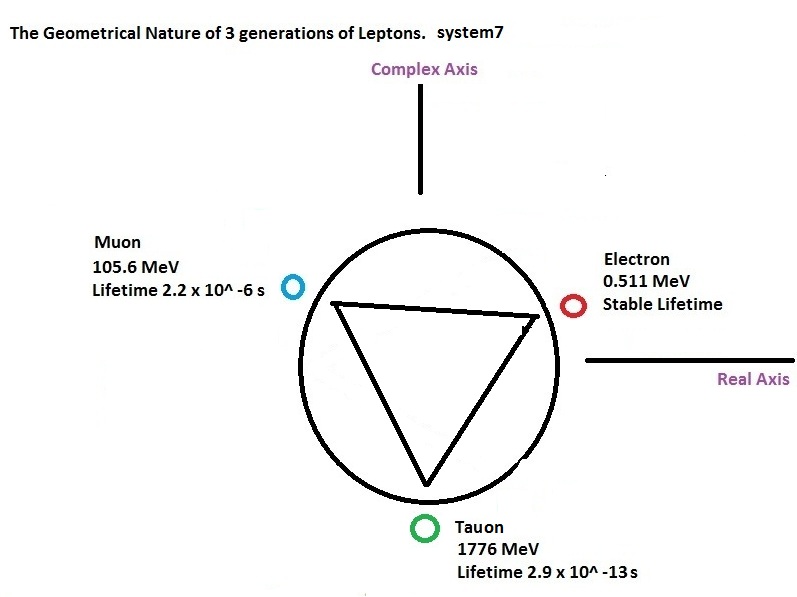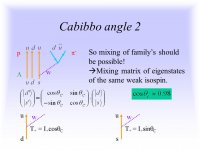I enjoyed Doctor Erik Verlinde's lecture:
(LIVE) Erik Verlinde Public Lecture: A New View on Gravity and the Dark Side of the Cosmos - YouTube
But understood only the vaguest idea that Dark Energy is where entangled information lurks. And this is quantum information, not Shannon's regular classical information and entropy.
A bit of progress on this B-Meson (bottom quark + other more regular lighter quark) decay that is interesting Cern LHCb. It must be linked to the famous Kaon (strange quark plus lighter one) decay and CP violation. A meson being a quark and antiquark AFAIK. Strange quarks are second generation particles. Bottom is third generation.
There is a quark model analogous to this lepton one that seeks to explain the three generations of particles and maybe the preponderance of matter in our universe.

The analagous offset from the real axis (that seems to generate the correct masses) is known as the Cabibbo angle in QCD. 13.02 degrees. If I understood Carl Brannen's paper, he also got 13 degrees for leptons, being 0.22 Radians. Very strange, it's almost like particles are twisted at an angle relative to space-time.
Cabibbo–Kobayashi–Maskawa matrix - Wikipedia
(LIVE) Erik Verlinde Public Lecture: A New View on Gravity and the Dark Side of the Cosmos - YouTube
But understood only the vaguest idea that Dark Energy is where entangled information lurks. And this is quantum information, not Shannon's regular classical information and entropy.
A bit of progress on this B-Meson (bottom quark + other more regular lighter quark) decay that is interesting Cern LHCb. It must be linked to the famous Kaon (strange quark plus lighter one) decay and CP violation. A meson being a quark and antiquark AFAIK. Strange quarks are second generation particles. Bottom is third generation.
There is a quark model analogous to this lepton one that seeks to explain the three generations of particles and maybe the preponderance of matter in our universe.
The analagous offset from the real axis (that seems to generate the correct masses) is known as the Cabibbo angle in QCD. 13.02 degrees. If I understood Carl Brannen's paper, he also got 13 degrees for leptons, being 0.22 Radians. Very strange, it's almost like particles are twisted at an angle relative to space-time.
Cabibbo–Kobayashi–Maskawa matrix - Wikipedia
Last edited:
But then you would make no sense, which makes no sense!Pete asks "What do you call this "area" my body is taking up?".
My wife says I'm either "taking up space" or I'm "a waste of space"!
I prefer to think of myself as a quantum wave function and, as such, "part of space". 😉
Better listen to your wife.😀
We can always rely on Steve to come up with a new angle on things! 😉The analagous offset from the real axis ... is known as the Cabibbo angle...
Nicola Cabbibo (1935-2010) is known for his work on the weak interaction which is where he came up with the Cabbibo angle and the Cabbibo matrix (see attachment, then explain it to me!).
The two physicists who extended his work into the Cabibbo-Kobayashi-Maskawa (CKM) matrix were awarded the Nobel prize in Physics in 2008 while poor old Cabbibo went unheralded!
It's a jungle out there in the world of particle Physics!

Wish I could hack my way through that jungle!
Nicola Cabibbo - Wikipedia
Attachments
Tireless experimentalist that I am, I thought I'd run the Cabibbo angle up the flagpole. 😀
Latest estimates put it 13.04 degrees:
13.04 / 360 = 0.036222222...
Seems a dull number. 😕
But there is more. 😀
326 / 9 = 36.2222222...
326 seems a dull number. But IT IS NOT! 🙂
Halve it and you get 163. An EXTREMELY interesting number:
Heegner number - Wikipedia
Latest estimates put it 13.04 degrees:
13.04 / 360 = 0.036222222...
Seems a dull number. 😕
But there is more. 😀
326 / 9 = 36.2222222...
326 seems a dull number. But IT IS NOT! 🙂
Halve it and you get 163. An EXTREMELY interesting number:
Heegner number - Wikipedia
Tireless experimentalist?
True.
However, as a credible mathematician, can't you tell that your number is up! 😀
True.

However, as a credible mathematician, can't you tell that your number is up! 😀
Is a Big Crunch likely if the nuclear reactions of all the suns convert much of their mass into energy? Seems like collective mass is being eliminated, and there's less of it to have a gravity retraction effect on the universe's expansion.
If all matter doesn't break down in this solar process, do some elementary particles, such as gravitons, migrate to some of the theoretical dimensions? (So the mass is conserved, but not destroyed, and is it likely the overall breakdown process could transition it "there"?)
I envision 🙂 it to be a photon/energy crunch rather than a solid matter event and it will take place when the last matter has turned into light and the whole universe is dark.
//
And if our conscious self is such that it is eternal by nature similar to perpetual motion where it continually reignites in a circular way by sheer will, perhaps the light we see will be that which we now see in our dreams and memory. Perhaps we are even now someone's dream or memory.I envision 🙂 it to be
//
You had almost infinite energy density, and through entropy, time (distance) was created and the result was an expanding universe that cooled in the process.
This is a fascinating condition. The universe cooled, but that means energy dissipated. Since energy can't be destroyed, could the universe cool without a greater volume of space to dilute this energy? If it could cool without expansion, where would the energy go?
Has this been posted here? It's a documentary on the LHC and such:
Particle Fever (2013) - CERN - YouTube
Particle Fever (2013) - CERN - YouTube
According to new research, it would appear that the Universe is actually getting hotter as time goes on!Maybe cooling is what happens when entropy creates time. :O
Researchers have looked at the evolution of the mean thermal energy density in the universe.
A study has cross-correlated eight sky intensity maps from the Planck and Infrared Astronomical Satellite missions with two million spectroscopic redshift references from the Sloan Digital Sky Surveys.
By analysing the spectra of far-infrared to microwave background light as a function of redshift, effectively looking back in time, a threefold increase in the density-weighted mean electron temperature throughout the history of the universe has been measured.
ShieldSquare Captcha
The Universe is warming because of the natural process of galaxy and structure formation. As time goes on, clusters of galaxies are getting hotter and hotter because their gravity pulls more and more gas toward them.
Not to my knowledge.Has this been posted here?
I'll give it a whirl when I've got 100 minutes to spare! 😎
@Galu but that does not change the fact that 13.8 billion years ago it was hot through and now it’s a few degrees above absolute zero. There are hot spots due to the things you mention, but it’s not as hot throughout as it originally was.
The universe is ‘lumpy’ with clumps of matter (collections of galaxies) and that should explain the hot spots.
(Serendipity I’m watching ‘How the Universe Works’ on the Big Bang and initial temperatures conditions 🙂 )
The universe is ‘lumpy’ with clumps of matter (collections of galaxies) and that should explain the hot spots.
(Serendipity I’m watching ‘How the Universe Works’ on the Big Bang and initial temperatures conditions 🙂 )
Last edited:
There is a difference between the "temperature of the universe", as measured in terms of the density-weighted mean electron temperature, and the temperature of the cosmic microwave background radiation (CMBR).
The temperature of the CMBR spectrum, formed about 400,000 years after the big bang, was 3000 K. It is is only modified subsequently by the universe's expansion, which stretches the wavelengths, leading to a lower temperature (currently 2.7 K).
In the time the density-weighted mean electron temperature has increased by about a factor of 3 the CMBR would have cooled from 5.4 K to 2.7 K.
On the supernova heating of the intergalactic medium | Monthly Notices of the Royal Astronomical Society | Oxford Academic
The temperature of the CMBR spectrum, formed about 400,000 years after the big bang, was 3000 K. It is is only modified subsequently by the universe's expansion, which stretches the wavelengths, leading to a lower temperature (currently 2.7 K).
In the time the density-weighted mean electron temperature has increased by about a factor of 3 the CMBR would have cooled from 5.4 K to 2.7 K.
On the supernova heating of the intergalactic medium | Monthly Notices of the Royal Astronomical Society | Oxford Academic
- Status
- Not open for further replies.
- Home
- Member Areas
- The Lounge
- What is the Universe expanding into..
